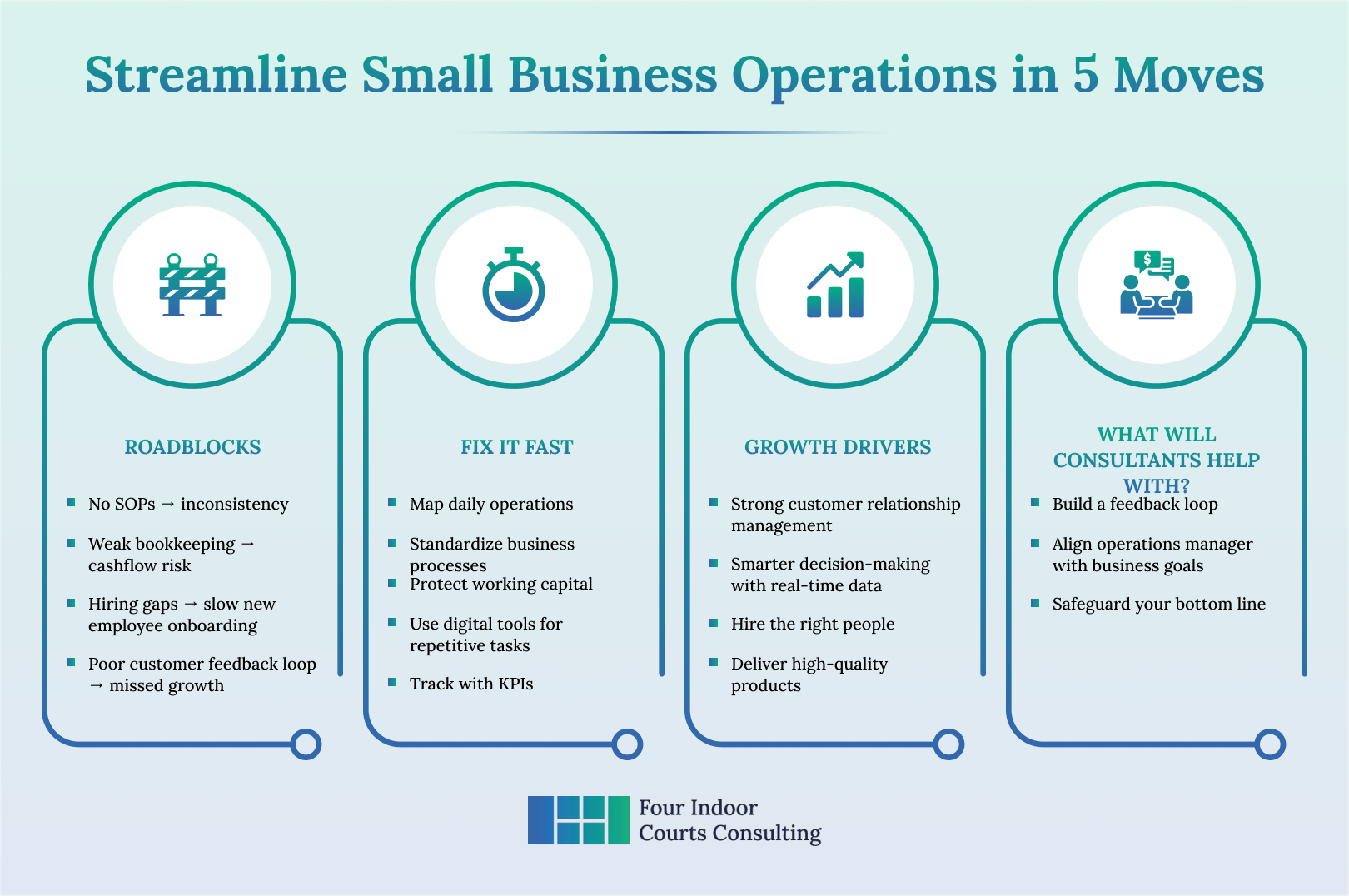Optimizing Small Business Operations for Sustainable Growth

Key Takeaway:
- Treat small business operations like a product: design, test, iterate.
- Map your operations on one page (from lead to cash). Fix the slowest step first.
- Use real-time indicators, not gut feel, for faster decision-making.
- Standardize how work is done, then automate only what has been proven.
- Protect working capital and financial health before chasing new business.
- Provide an operations manager with clear metrics and the authority to remove bottlenecks.
Challenges Faced by Small Business Owners
You’re wearing five hats and two of them don’t fit. The gap between what customers expect and what your team can deliver is evident in late orders, rework, and cash crunches. The fastest relief comes from clarifying daily operations, stabilizing cash flow, and providing team members with simple, documented ways to succeed.
Understanding Your Daily Operations
Managing daily tasks to meet customer demand: Block your day around the flow of daily tasks that create value intake, fulfillment, delivery, and follow-up. A simple capacity chart reveals if you can meet customer demand next week. When it’s tight, pause low-value activities and streamline operations where they hurt most.
Improving customer feedback loops: Build a lightweight customer feedback loop: a two-question survey at delivery and a 30-day check-in. Tag issues (quality, speed, comms) so your operations team knows exactly what to fix.
Balancing cash flow management and working capital: Healthy cash flow management starts with a 13-week cash forecast. Protect working capital with deposits on large orders, shorter payment terms, and inventory minimums you’ll actually honor.
Overcoming bookkeeping inefficiencies: Tidy, timely bookkeeping is a competitive advantage. Close the month by day five, publish a one-page ops-and-finance snapshot, and make it the default agenda for your operations manager.
Streamlining operations for cost-effectiveness: List your top three bottlenecks and address them in two-week sprints. Aim for measurable cost-effectiveness: minutes saved, errors reduced, dollars protected.
Common Issues in Business Processes

Lack of standard operating procedures: If results depend on who’s on shift, write standard operating procedures. One page per task, screenshots where needed, and a short video if it’s tricky.
Difficulty in streamlining processes and repetitive tasks: Don’t automate chaos. First, simplify the business processes. Then use tools to handle repetitive tasks reliably.
Challenges with hiring and onboarding new employees: Great onboarding cuts ramp time in half. Give new employees checklists, role outcomes, and a 30-60-90 plan tied to key performance indicators.
Finding the right people for key roles: Define outcomes first, then hire the right people to own them. For pivotal roles, trial projects often outperform lengthy interviews.
Maintaining operational efficiency in production processes: Enhance operational efficiency in the production process through short stand-ups, visible queues, and stop-the-line rules when quality standards are compromised.
Strategies for Effective Operations Management
Effective ops is boring in the best way. It runs the same way, every day, with clear handoffs. Give an operations manager authority to rebalance workloads, enforce standards, and escalate blockers in real-time.
Key Aspects to Build a Solid Foundation
Defining business goals and key performance indicators: Choose three business goals that matter now (profit, lead time, quality), then set the key performance indicators that prove progress.
Enhancing customer relationship management: Utilize simple customer relationship management practices, including a clean pipeline, next-step dates, and post-sale follow-ups, to foster referrals.
Establishing best practices for business functions: Document the best practices for each of your core business functions: sales, fulfillment, and support, and keep them readily accessible for all team members with a single click.
Producing high-quality products using raw materials efficiently: Track yield. Small improvements in raw material usage add up to significant savings and high-quality products that customers notice.
Improving decision-making with real-time customer data: Make choices with real-time customer data: what’s selling, who’s churning, where complaints cluster. That’s how leaders make confident calls.
Streamline Small Business Operations in 5 Moves

The Role of Digital Tools and Technology
Adopting artificial intelligence for repetitive tasks: Use Artificial Intelligence to draft responses, summarize tickets, and classify inbound requests after you’ve standardized the steps.
Leveraging project management software for task management: Select one project management software and utilize it for task management, rather than using it as a suggestion box: clear owners, due dates, and definitions of done.
Utilizing social media and email marketing for outreach: Stay focused: one social media platform where your buyers actually hang out, plus consistent email marketing that nurtures leads and reactivates past clients.
Streamlining processes with customer data insights: Let customer data guide where to Streamline Processes, such as cart drop-off spots, long support threads, or order rework loops.
Enhancing marketing strategies to drive business growth: Tight marketing strategies turn attention into revenue, pair campaigns with ops capacity so you deliver on every promise and fuel steady business growth.
The Importance of Business Consultants
A strong consultant aligns small business operations with cash and capacity, installs dashboards you’ll actually use, and mentors business leaders through tough trade-offs.
How Consultants Help Streamline Operations?
Optimizing small business development and processes: Think Small Business Development with guardrails: clean business processes, proven playbooks, and simple quarterly plans.
Creating a feedback loop for continuous improvement: Consultants establish a weekly feedback loop with metrics, wins, and blockers to ensure improvements are sustained.
Improving operational efficiency and cost-effectiveness: Expect measurable gains in operational efficiency within 30–90 days: fewer errors, faster cycle times, better labor utilization.
Focusing on financial health and the company’s bottom line: Advisors protect financial health and the bottom line, with margin reviews, pricing checks, and clear ROI rules before you scale.
Why Small Business Leaders Seek Expert Guidance?

Achieving long-term success with sustainable business models: Experts help design a resilient business model that supports long-term success without overextending capacity.
Ensuring a competitive edge through problem-solving strategies: An external perspective sharpens your competitive edge through structured problem-solving and prioritization.
Improving the production process for high-quality outputs: A fresh audit of your production process often reveals quick wins, such as station layout, QA checkpoints, or supplier tweaks.
Aligning operations manager roles with business goals: Clarify how the operations manager advances business goals and publish the scorecard everyone can see.
Steps to Ensure Small Business Success
Streamline operations to meet customer demand effectively: Your first step: map the order-to-cash process, then remove the longest delay to consistently meet customer demand.
Adopt new technology to improve task management: Adopt new technology only after the process is stable; then automate to strengthen task management and visibility.
Monitor financial planning with strong bookkeeping practices: Run monthly financial planning as a ritual. Early warning lets you avoid expensive business funding or a rushed small business loan.
Hire the right people to strengthen your team: When in doubt, hire slow. The right people reduce fire drills and make a successful small business possible.
Focus on delivering high-quality products for customer loyalty: Quality drives customer loyalty. When in conflict, prioritize protecting service levels before promoting more stringent measures.
FAQs
Q1: How do I know where to start improving my company’s operations?
Begin with a one-page map of your operations (lead → quote → fulfill → bill → support)—time each step in real-time for a week. The slowest step is your first fix.
Q2: What if I don’t have a budget for big systems right now?
Stabilize processes first; then choose lightweight digital tools. Many wins come from clearer handoffs and checklists, not expensive platforms.
Q3: When should I bring in a consultant?
If issues persist despite effort, or you need speed. Consultants compress learning, implement best practices, and safeguard financial health as you grow.
Q4: Will operational improvements help me acquire a new customer or just reduce costs?
Both. Faster, more reliable delivery wins trust, improves reviews, and converts inquiries into new customers more often.
Q5: What internal role is critical to keep momentum?
An accountable operations manager with authority to resolve blockers and keep effective operations management humming.






.jpg)